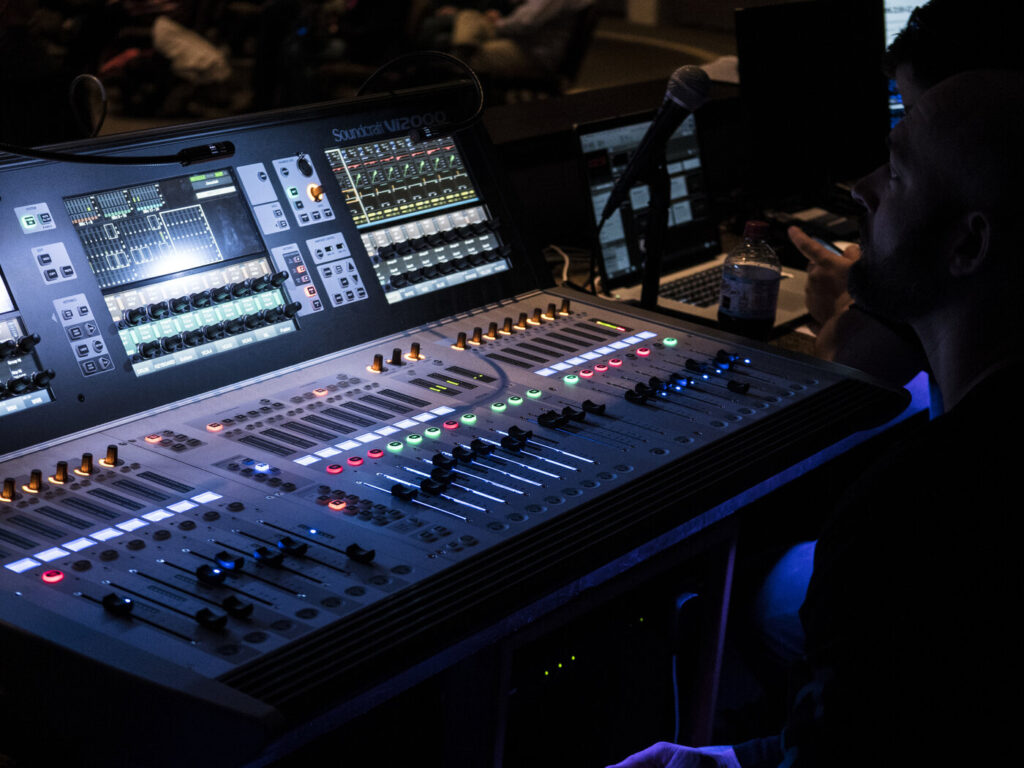Church audio problems are a common issue that can lead to frustration for churchgoers, pastors, and church tech teams. They may cause an overall poor experience and can even lead to members leaving the church. That said, understanding the cause of audio problems is the first step in addressing these issues and creating a better experience for everyone.
Below are just a few notable examples.
1. Excessive Reverberation
Possible causes of audio issues include the insufficient structural design or slight timing differences between individual speakers. Timing issues arise when speakers are separated by a significant distance and must address an audience from opposite sides of the room. When a speaker is mounted on the back wall of a long, narrow church sanctuary, the sound from that speaker should be slightly delayed.
When the rear speaker emits its waves, the front speaker’s waves will make it to the back of the sanctuary later. The easiest way to ensure that even the farthest seats in the house can hear the presentation is to position all of the speakers at the front of the room and adjust the volume and angle of the speakers accordingly.
When sound waves collide with flat, reflecting surfaces, as in some buildings, the result is similar to that of bumper cars. For instance, if a church were to host a gathering in a gym or multipurpose building with hard flooring, the conversations at the tables would create a muffled hum that steadily gains volume. A person who speaks will hear their own voice echoing from different locations. Fabric panels, banners, or baffles affixed to the walls or ceiling can solve this issue.
2. Feedback
An annoying squeal is produced when the amplified sound from a speaker or monitor is sent back through the microphone and amplified once again. The positioning of the monitors and the microphones causes this reverberation. Feedback occurs when a singer doesn’t leave enough space between their microphone and the monitor or when the singer aims the microphone straight into the monitor.
Feedback might also occur when the speaker stands in one place and points the microphone in different directions. Several companies make feedback controllers that automatically change the audio frequency in churches with these speakers to prevent feedback.
3. Insufficient Training
It doesn’t matter how much money is spent on sound equipment if the professionals who utilize it aren’t trained to get the most out of it. If someone shows genuine enthusiasm for the role of sound technician, you should invest time in them until they reach the required level of competence. Purchase instructional resources, including books, videos, and professional journals.
Equipment used incorrectly may degrade even the best sound system. For example, if a vocalist places the mic too far from their mouth, the engineer may have to crank up the volume on that channel, which could lead to feedback. Performers should turn their mics up or down depending on how loud their vocals are. The microphone should be held further from the lips when singing a loud, powerful note and closer to the mouth when singing a low, gentle tone.
4. Poor Communication
Performers have a right to know what their technicians are up to. A performer may request more reverb in her monitor, but the sound engineer understands that vocalists keep their pitch more accurately when they don’t hear reverb. Although the sound engineer could add some reverb to the system and turn it down on the monitor, the singer’s performance would suffer if they didn’t know what was going on. The lesson for technicians is to maintain diplomatic etiquette. The takeaway lesson for performers is to have faith in the technician.
5. Imbalanced Sound
Monitor wash is a common cause of muddy audio for inexperienced operators. If the worship leader is using a monitor on the stage, it is typically angled toward the back wall, away from the congregation. Too much volume or too many different sounds in the mix can cause the sound to echo off the back wall and blend with other sounds before reaching the crowd.
A simple volume change on the screen may solve the problem. Multiple screens may be required for a particularly large worship ensemble. Yet, mastering the art of monitor mixing takes time and effort.
Conclusion
Church audio problems often arise from a combination of issues. Poor sound system design, inadequate acoustics, and improper use of equipment can all lead to suboptimal sound quality. In order to ensure that sound is optimized, it is important to invest in a professional sound system design and ensure that the acoustics of the space are properly taken into account.
By addressing these issues, churches can improve the sound quality of their services and create a more engaging experience for their congregation.
If you are looking for a great source of audio-visual equipment for churches, look no further than our high-quality selections here at Messenger AVL. We design and install audio, video, and lighting solutions so your technical dreams become reality. Call us today, and let us provide your church with all the necessary technical amenities it needs.



